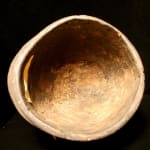Sande Society Mende Helmet Mask, 19th Century CE - 20th Century CE
Wood, patina
13
DA.434 (LSO)
Further images
This outstandingly elegant helmet mask was made by the Mende people of Sierra Leone. It pertains to the Sande women’s initiation society, the only all-female masking society in Africa. It...
This outstandingly elegant helmet mask was made by the Mende people of Sierra Leone. It pertains to the Sande women’s initiation society, the only all-female masking society in Africa. It displays both typical and unusual characteristics. The face is usually defined by beading, or has very sharply cut-away brows with a distinct, sharp chin. This example has the typical tall forehead, but has a relatively naturalistic, simple face with a quizzical expression, a retrousse nose, thin lips and narrow oval eyes banded with hatched lines. The cheeks are broad also, giving the face a decidedly reduced appearance. There is a hatched band separating the face from the coiffure, which is very complex, and surmounted by a triple crest design. The patina, unusually, is encrusted; this is most likely caused by halei materials (see below). Various of these elements have specific meaning. Complex hairstyles are considered beautiful by the Mende, while banding separating face from hair represents fecundity and attractiveness. The neck rings represent water, which is the home of the “Now” spirit (see below).
While currently being marginalized by pressure from Islamic conventions concerning the figurative in art, Mende society was originally controlled by the Sande group. They were charged with responsibility for a sacred medicine known as halei, which was bestowed by deities upon the Mende and their close neighbours, the Gola. The power of halei was displayed during prolonged “Now” dancing masquerades, which were performed using these masks and long, dark costumes, although the actual secrets of halei were never divulged. There were various levels of Sande initiation, each with its own mask. The more ornate the mask, the higher the grade. Once made and endowed with magic through strategic application of oil and halei materials, the mask stays with the owner until she retires, dies, or is promoted.
These masks are rare and beautiful pieces of socially important African art, and this is a very unusual and desirable example of the genre.
While currently being marginalized by pressure from Islamic conventions concerning the figurative in art, Mende society was originally controlled by the Sande group. They were charged with responsibility for a sacred medicine known as halei, which was bestowed by deities upon the Mende and their close neighbours, the Gola. The power of halei was displayed during prolonged “Now” dancing masquerades, which were performed using these masks and long, dark costumes, although the actual secrets of halei were never divulged. There were various levels of Sande initiation, each with its own mask. The more ornate the mask, the higher the grade. Once made and endowed with magic through strategic application of oil and halei materials, the mask stays with the owner until she retires, dies, or is promoted.
These masks are rare and beautiful pieces of socially important African art, and this is a very unusual and desirable example of the genre.





